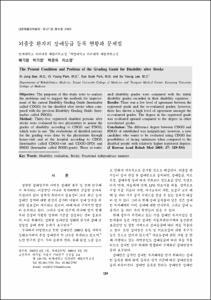KUMEL Repository
1. Journal Papers (연구논문)
1. School of Medicine (의과대학)
Dept. of Rehabilitation Medicine (재활의학)
뇌졸중 환자의 장애등급 등록 현황과 문제점
- Keimyung Author(s)
- Park, Gi Young; Lee, So Young
- Department
- Dept. of Rehabilitation Medicine (재활의학)
- Journal Title
- 대한재활의학회지
- Issued Date
- 2003
- Volume
- 27
- Issue
- 3
- Abstract
- Objective: The purposes of this study were to analyze the problems and to suggest the methods for improvement of the current Disability Grading Guide (hereinafter called CDGG) for the disabled after stroke when compared with the previous Disability Grading Guide (hereinafter called PDGG).
Method: Thirty-five registered disabled persons after stroke were evaluated by two physiatrists to assess the grades of disability according to CDGG and PDGG, which were in use. The evaluations of disabled persons for the grading were done by the physiatrists through house-visit and at the hospital according to CDGG (hereinafter called CDGG-visit and CDGG-OPD) and PDGG (hereinafter called PDGG-grade). These re-evaluated disability grades were compared with the initial disability grades recorded in their disability registries.
Results: There was a low level of agreement between the registered grade and the re-evaluated grades; however, there has shown a high level of agreement amongst the re-evaluated grades. The degree in the registered grade was evaluated upward compared to the degree in other reevaluated grades.
Conclusion: The difference degree between CDGG and PDGG of established was insignificant; however, a new candidate who wants to be evaluated using CDGG has possibilities of facing unfairness when compared to the disabled people with relatively higher registered degrees. (J Korean Acad Rehab Med 2003; 27: 329-334)
ated disability grades were compared with the initial disability grades recorded in their disability registries.
Results: There was a low level of agreement between the registered grade and the re-evaluated grades; however, there has shown a high level of agreement amongst the re-evaluated grades. The degree in the registered grade was evaluated upward compared to the degree in other reevaluated grades.
Conclusion: The difference degree between CDGG and PDGG of established was insignificant; however, a new candidate who wants to be evaluated using CDGG has possibilities of facing unfairness when compared to the disabled people with relatively higher registered degrees.
- Alternative Title
- The Present Condition and Problem of the Grading Guide for Disability after Stroke
- Publisher
- School of Medicine
- Citation
- 배기정 et al. (2003). 뇌졸중 환자의 장애등급 등록 현황과 문제점. 대한재활의학회지, 27(3), 329–334.
- Type
- Article
- ISSN
- 1225-584X
- Appears in Collections:
- 1. School of Medicine (의과대학) > Dept. of Rehabilitation Medicine (재활의학)
- 파일 목록
-
-
Download
 oak-bbb-3463.pdf
기타 데이터 / 258.37 kB / Adobe PDF
oak-bbb-3463.pdf
기타 데이터 / 258.37 kB / Adobe PDF
-
Items in Repository are protected by copyright, with all rights reserved, unless otherwise indicated.